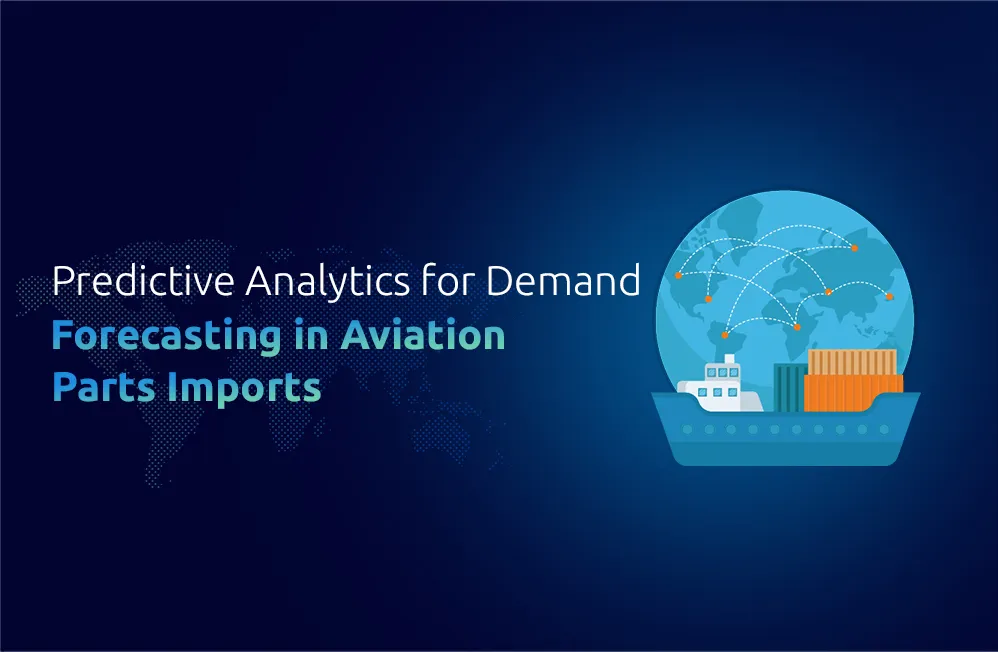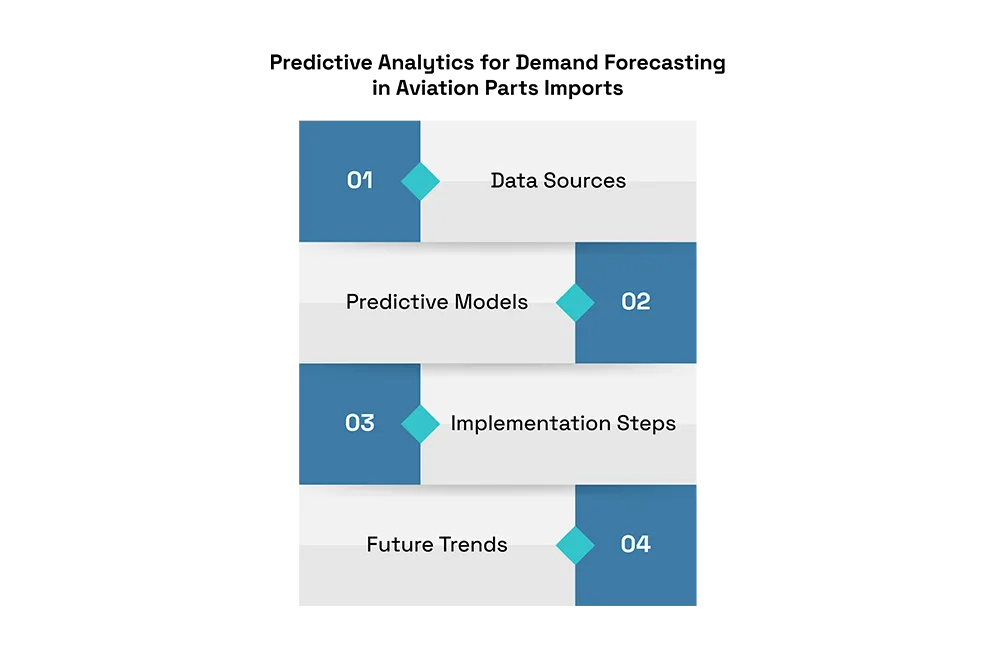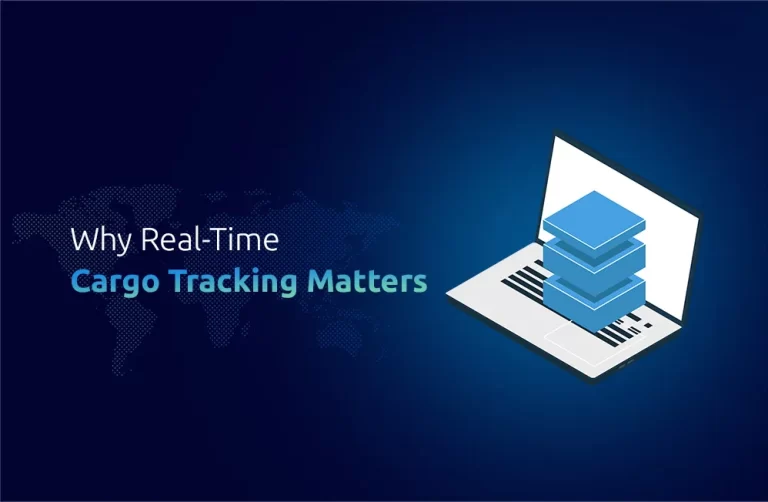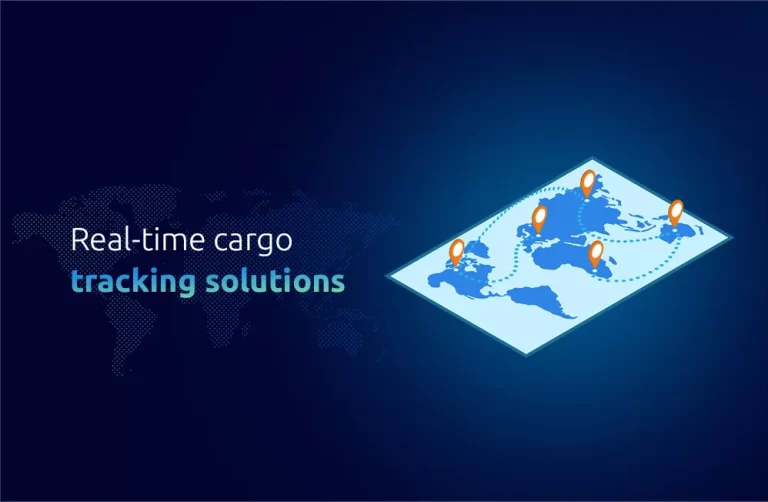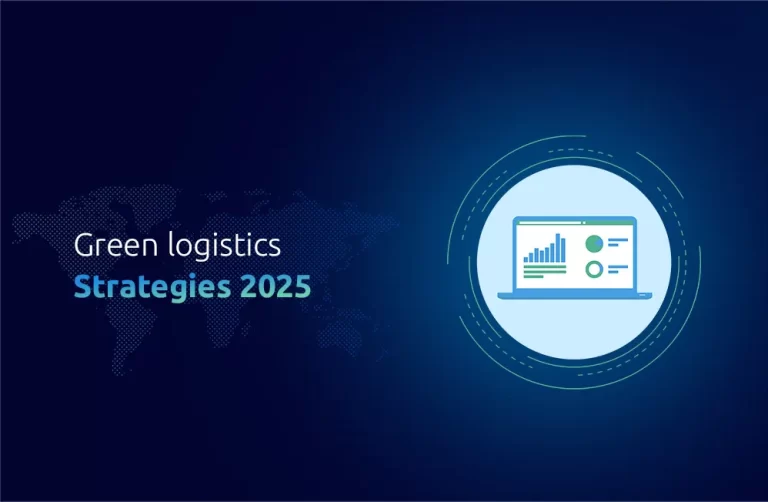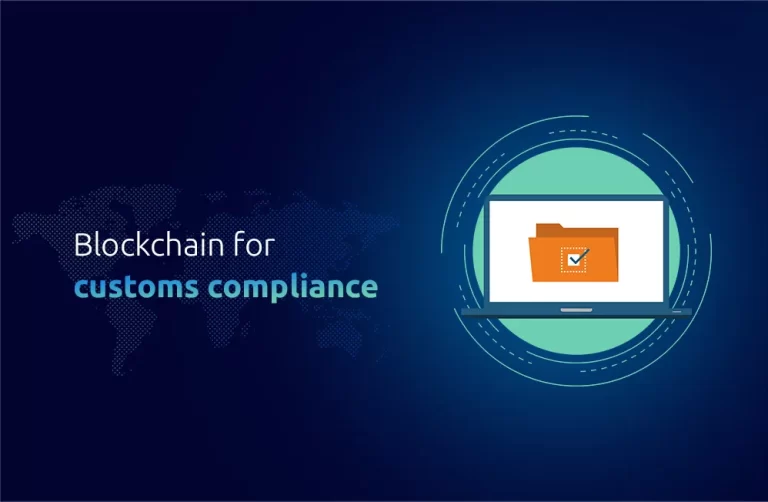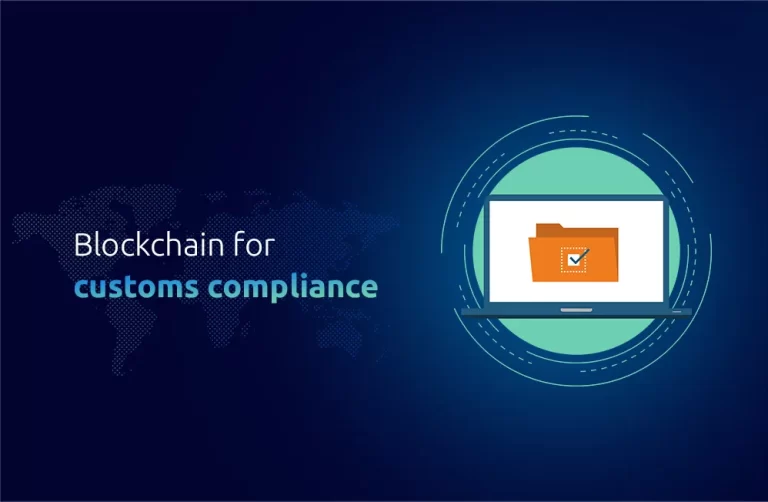Introduction
The aviation sector depends on the reliable delivery of top-notch parts to ensure aircraft operation and safety. The greatest method of streamlining supply chains while decreasing operational costs appears in predictive analytics for demand forecasting as technology progresses quickly. The accurate forecast of aviation part demand allows companies to determine supply chain decisions that ensure on-time deliveries with reduced stockout risks. Predictive analytics produces future trend predictions by combining historical data with statistical algorithms & machine learning processes.
Organizations use this data analytic technique for aviation parts import demand forecasting to enhance supply chain process control and minimize inventory costs for freight forwarding and warehousing expenses. The following blog discusses how predictive analytics impacts demand forecasting for aviation parts imports and logistics processes’ operational transformation.
Predictive Analytics Improves Demand Forecasting
Every supply chain operation needs demand forecasting as its core operational element. The tool helps predict aviation parts import demand changes to assist businesses in determining their order quantities and anticipating delivery delays. Predictive analytics allows businesses to create more precise forecasting models through the inclusion of different data sources, which consist of:
Historical Data: To predict future demand, businesses should analyze past data about aviation part consumption amounts. Businesses achieve better part requirement forecasting by combining historical order data analysis, seasonal patterns, and trend studies.
Supply Chain Insights: The predictive analysis examines supply chain data to derive valuable information. Evaluating supplier performance alongside lead time and delivery delays enables companies to forecast supply chain risks and create alternative sourcing solutions.
Global Events & Market Trends: The changing regulatory policies, economic dynamics, & geopolitical conditions, such as changes in customs regulations or modifications to the Generalized System of Preferences, can affect specific part demand. The tracking system uses predictive analytics to monitor various factors, which enables accurate forecast modifications.
Logistics/Freight Forwarding Data: Research models utilize data from logistics & freight operations to investigate shipping durations, customs process times, and Incoterms standards, including DDP & DAP.
The Role of Predictive Analytics | Logistics | Supply Chain Management
The integration of predictive analytics into logistics & supply chain management allows for better decision-making in areas like:
Optimizing Freight Forwarding & Air Forwarding Services: Businesses can work with cargo freight forwarders & freight forwarding service providers to get optimal shipping routes, which lowers expenses through accurate aviation parts demand forecasting. Advanced analytics systems make shipping recommendations based on predicted demands and delivery urgency by suggesting air freight, maritime, or ground transportation.
Warehouse Management: The business benefits from warehouse management through predictive analytics, which accurately predicts needed part quantities and develops optimal storage arrangements. Automated guided vehicles (AGVs) function as a warehouse optimization solution by creating better material flow patterns, thus increasing operational efficiency and lowering cost expenses.
Inventory Control: By using predictive analytics technologies, Businesses can prevent overstocking or understocking situations through inventory control. Predictive analytics enables businesses to forecast demand accurately, which means they can keep proper stock levels instead of storing excess products and avoiding outdated perishable items.
Clearance and Compliance: Customs clearance procedures lead to delayed delivery of parts because of process delays. Predictive modeling allows companies to forecast customs clearance problems concerning HS codes and delivery duty paid shipping. Businesses can maintain operational continuity by correctly predicting possible delays through advanced planning.
Incorporating Incoterms and Shipping Costs: Businesses need to understand the import and export duties between them by properly defining Incoterms terms DAP, DDP, and others and their associated shipping expenses. Through predictive analytics, businesses can predict future shipping terms or changes in regulatory requirements and select effective shipping methods that minimize costs.
With the recent increase in aviation variant analysis, there have been changes in the airline demand forecast methods particularly for aviation section imports. According to market research, the aviation parts market is expected to grow at a CAGR of 7.2% from 2021 to 2026 due to the growth of air travel and the improvement of supply chain solutions. This growth demands the application of predictive analytics for aviation to meet new trends that may emerge as companies continue to seek ways of handling the dynamic nature of demand. Thus, it is possible to enhance the demand forecasting in aviation companies, optimize supply chains, and make them more resistant and versatile in terms of materials placement worldwide.
Benefits of Predictive Analytics | Demand Forecasting
The use of predictive analytics in demand forecasting for aviation parts imports offers multiple benefits:
Reduced Operational Costs: Businesses that accurately predict part demand requirements minimize overstocking expenses and overhead related to understocking through better distribution of resources. Total warehouse space reaches maximum utilization while inventory costs decrease along with transportation expenses.
Improved Customer Satisfaction: A quick and accurate aviation parts delivery maintains its core importance to boost customer satisfaction. The application of predictive analytics enables businesses to check when needed materials will be ready for delivery and ensure prompt deliveries leading to customer satisfaction.
Better Supply Chain Collaboration: Businesses achieve better supply chain collaboration through precise forecasting by working more effectively with suppliers, freight forwarders, and logistics providers. Maintaining an optimized supply chain enables businesses to achieve enhanced visibility, shorter lead times, & improved communication.
Enhanced Decision Making: Predictive analytics enables businesses to receive actionable insights that fuel their decision-making processes. Business operations become more flexible through demand forecasting, which allows companies to take proactive steps against market changes while reducing potential disruptions.
Optimized Use of Resources: Implementing predictive models empowers organizations to distribute resources successfully. Businesses can develop maximum resource efficiency by making accurate demand forecasts, leading to optimized utilization of the human labor force, warehouse space, and vehicles.
Did You Know?
Recent market research shows the aviation parts market tiering for an estimated 7.2% Compound Annual Growth Rate from 2026 until 2021. The market expands because consumers need more air transportation alongside current technological developments across the supply chain and predictive analytics applications.
Conclusion
Businesses better understand aviation part demand forecasting and supply chain control by utilizing predictive analytics. Using future trend predictions through data allows businesses to enhance operational efficiency while lowering costs and improving customer satisfaction. Predictive analytics is necessary for aviation companies to stay market competitive while meeting the developing marketplace requirements. One Union Solutions dedicates itself to delivering superior services across aviation equipment logistics and supply chain management domains. By implementing predictive analytics technology, you can contact us now for supply chain optimization solutions.
FAQ’s
Q. What is predictive analytics used for?
Ans: Predictive analytics utilizes historical data, statistical models, & machine learning technologies to predict demand and trend predictions, enabling businesses to make better decisions.
Q. How does predictive analytics impact supply chain management?
Ans: Predictive analytics helps optimize inventory levels, predict shipping times, and improve collaboration with suppliers – ultimately decreasing delays and costs associated with delivery delays & supplier miscommunication.
Q. Can you outline some key benefits of predictive analytics in aviation parts import?
Ans: Benefits include lower operational costs, improved customer satisfaction, enhanced decision-making processes, and optimized resource utilization.
Q: Can Incoterms DDP and DAP apply to aviation parts imports?
Ans: Incoterms outline the obligations & responsibilities of both importer – and exporter that affect shipping costs, delivery schedules, and customs clearance procedures.
Q. Why is Warehousing Important in Forecasting Demand for Aviation Equipment?
Ans: Warehousing services enable businesses to store parts efficiently, manage inventory, & fulfill orders quickly when demand fluctuates, which are crucial capabilities in an unpredictable business world.

